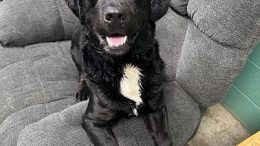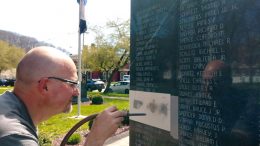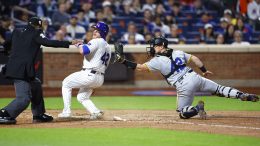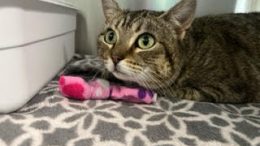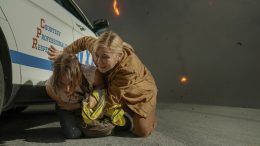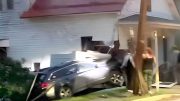(AP) — When faced with a 600-pound charging grizzly armed with four-inch long claws, we all hope the instructions we’ve received on how to properly use bear spray are scientifically tested and universal.
That’s an assumption that could get you killed, said Chuck Bartlebaugh, director of the Be Bear Aware Campaign.
Almost 30 years after bear spray first appeared on store shelves, the onus on knowing what works and what doesn’t remains with a buyer.
“I think that’s scary,” Bartlebaugh said. “It’s disconcerting to me that after 28 years of bear spray being on the market, there is no structured, professional, bear-biologist-related instructions out there for people that I would consider accurate.”
As a result, people’s expectations don’t always match with reality.
Sometimes people wait too long to deploy the spray because of what they’ve read or been taught. Or they let their can of spray get too cold and it doesn’t work as advertised. Or they aim too high and the spray goes over the bear’s head.
“People have been taught that it works instantaneously or that a can with four seconds of spray is sufficient,” Bartebaugh said. “Their expectations are wrong.
“If they spray over the top of a bear and it’s running under the cloud, they will be mauled,” he said. “If they wait until the bear is 10 feet away as suggested in some training videos, they are going to be mauled or something possibly worse.”
But when deployed properly, he said, bear spray works “almost 100 percent of the time.”
Over the last three decades, Bartlebaugh has interviewed more than 300 people who have used bear spray following a close encounter with bruins. About 65 percent of those didn’t know the brand they were carrying or how far the can would spray or how long that spray would last.
“Over marketing with claims that bear spray will work instantaneously has led to people having a false sense of security,” he said. “We have detected a pattern of people waiting to spray bears in the eyes, nose and mouth or waiting until it is within 10 to 20 feet with the idea the bear is going to hit a brick wall.”
With a bear barreling down on you at 35 mph, waiting until it’s 15 feet away gives the spray less than a half a second to take effect.
“It will still work, but by then the bear is already locked in on you and it may be too late for it to divert its charge,” he said.
Pain isn’t what deters a bear’s charge when it runs into a cloud of capsaicin. The inflammatory agent causes the bear’s throat and nasal passage to swell and it has a hard time breathing. Its eyes begin to water and ears ring.
“When bears fight, they can withstand a great amount of pain, but losing their ability to breathe deeply and be able to exhale reduces their ability to fight,” Bartlebaugh said. “Their nose and nasal passage close down, their ability to focus and sight is visibly reduced, stopping their ability to become focused on their target. Their ears swell and start ringing. The bear has basically lost its tools to prepare to fight with.”
If the situation allows, Bartlebaugh urges people not to wait until a charging bear is close to deploy their spray. Under the best circumstances, he said the spray should be fired when the bear is still 60 feet away.
In that case, the bear will hit the cloud at about 30 feet and allow some time for the spray to work.
Detractors of bear spray point to the times when a person is mauled despite the use of the deterrent. A recent, widely circulated article suggested firearms work far better to keep bears at bay.
Bartlebaugh said there are times, such as a day when the wind is blowing hard, when firearms in the hands of the well trained could outperform bear spray. But he chooses not to carry a gun.
“I’m a supporter of firearms,” he said. “If I was trained and had the dedication it takes to become proficient, I would probably carry one too.”
Longtime state bear biologist Jamie Jonkel has heard the complaints about bear spray before.
“Since bear spray was invented, there have been naysayers,” Jonkel said. “There are a lot of people who have used it inappropriately and ineffectively.”
The bear biologist has seen firsthand just how effective bear spray can be.
“I’ve sprayed a lot of bears for management,” he said. “I know it’s a very effective tool. It’s like having matches in your pocket and a knife on your belt when you go into the woods. It’s a survival tool. The more time you spend in the woods, the more likely you are going to encounter a bear or two. When you do, you have to hope you can control the situation.”
Jonkel uses the spray to recondition bears that have learned they can get a bite to eat near someone’s home or from a garbage can.
“They’ve gotten used to people throwing candy out the back porch,” he said. “Instead of finding hard candy, I give them a good shot of bear spray. They can’t believe what just happened. They start pawing at their eyes, their head goes right down and then they get out of there.”
Jonkel has also set up a trap in garbage cans that gives problem bears a good blast of spray when they stick their heads in a place it doesn’t belong.
“They bowl over backwards and run away as fast as they can,” he said. “It’s a great tool to encourage them to get out of Dodge.”
Jonkel said he always carries a large can of spray when he’s in the woods.
For it to be effective in those chance encounters, the biologist said people need to be proficient in deploying the spray and generally be aware of their surroundings to see a bear coming their way.
“People need to become proficient with the feeling of the can and how to operate it in a hurry,” Jonkel said. “Half the time when I’m in the woods, I’m twirling it around my finger or tossing it in the air while I’m running through scenarios in my head. It’s not something new. Humans have been doing this for 30,000 years, living with this same species, but for some reason over the last 100 years we’ve forgotten that you need to be mentally prepared for any situation that might arise around the next corner in the woods.”
Bear spray also works well for deer, moose and other critters that might be a threat.
“I always have it with me,” he said.
Longtime wildlife photographer and author of two books chronicling the lessons he’s learned about hiking in grizzly country, Tim Rubbert of Whitefish has twice deployed bear spray on grizzlies
“It definitely works,” Rubbert said. “People who say it doesn’t work have never used it on a bear.”
In September 1993, he and a friend, Jim Cole, were on their way back to the Glacier National Park trailhead. The two were separated when his friend surprised a sleeping grizzly bear next to the trail.
“That bear was on him immediately,” Rubbert said. “It made a long sound like a locomotive letting off steam. He had bear spray but didn’t have a chance to get it out. No chance at all. The bear went right for his head. It also bit him on the wrist and the hip.”
By that time, Rubbert had his bear spray out and shot a short burst.
“Bear spray sounds like a huffing bear,” he said. “The bear looked up and immediately charged me. I emptied the can of bear spray on the bear. The bear stopped five feet in front of me and took off.”
Rubbert guesses he was about 40 feet away when the bear first attacked his friend.
Ever since then, he’s carried two cans of bear spray whenever he ventures into the woods.
“We still had 10 miles to hike out and I had no bear spray left,” he said.
That decision to carry two cans came in handy in his second close encounter in August 1999.
Rubbert was by himself on the face of a cliff in Glacier glassing for grizzlies when a sow grizzly and her cub suddenly appeared. After reaching down to grab one of the cans off the ground, he yelled “no” at the sow that was coming directly at him.
Both bears stopped, stood on their hind legs and began to huff. When the sow came down and began to charge, Rubbert let loose with the spray. The wind was blowing hard and he watched the spray take a 90 degree turn away from the bear.
But the whooshing sound was enough to break off the charge and the bear began to circle. Rubbert retreated down the face of the cliff to the point that only half his body was now exposed to the bear. When she decided to charge again, his bear spray struck her right in the face.
She turned and left.
On both occasions, Rubbert said there wasn’t time to ponder what his best move would be.
“It happens so fast that you go into automatic pilot or you panic, one of the two,” he said.
This will be Rubbert’s 34th field season.
“I’ve seen thousands of grizzlies in that time,” he said. “Why wouldn’t you? When you hike in grizzly country, you better be looking for them. The most important thing to do is make noise. You look at the history of encounters, it’s when you come up on a bear at close range that bad things happen. Basically what you’ve done is scare the bear. What do you expect it to do? It’s going to try to defend itself.”
Rubbert carries two cans of bear spray throughout the year.
“I’ve seen grizzly bear tracks in Glacier in January,” he said. “You can run into a bear any time of the year.”
Rubbert encouraged people to get a practice can to get an idea of how it works.
“It lets you know what you’re getting yourself into,” Rubbert said. “What it sounds like coming out. It’s not going to shoot as far as the real stuff, but it will give you an idea of what the spray pattern looks like.”
Rubbert doesn’t have any plans for trading in his bear spray for a gun.
“One, I don’t want to kill a bear,” he said. “Two, I know bear spray works.
“You have to be a damned good shot” with a gun when a bear is charging, he said. “People have shot… and missed it or hit it in a non-vital area and wounded it. If you wound a grizzly, someone has to go look for it. You’re putting other people’s lives in danger.”










